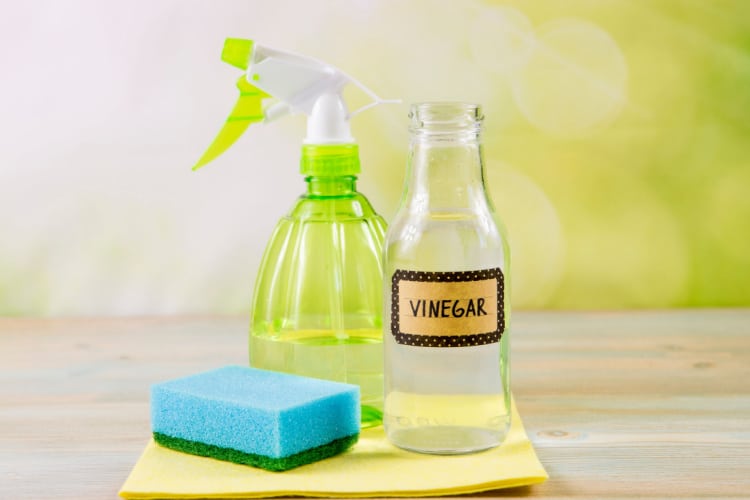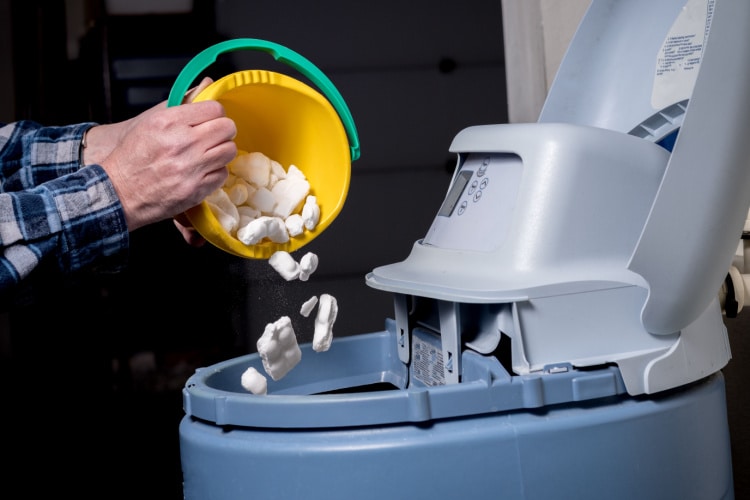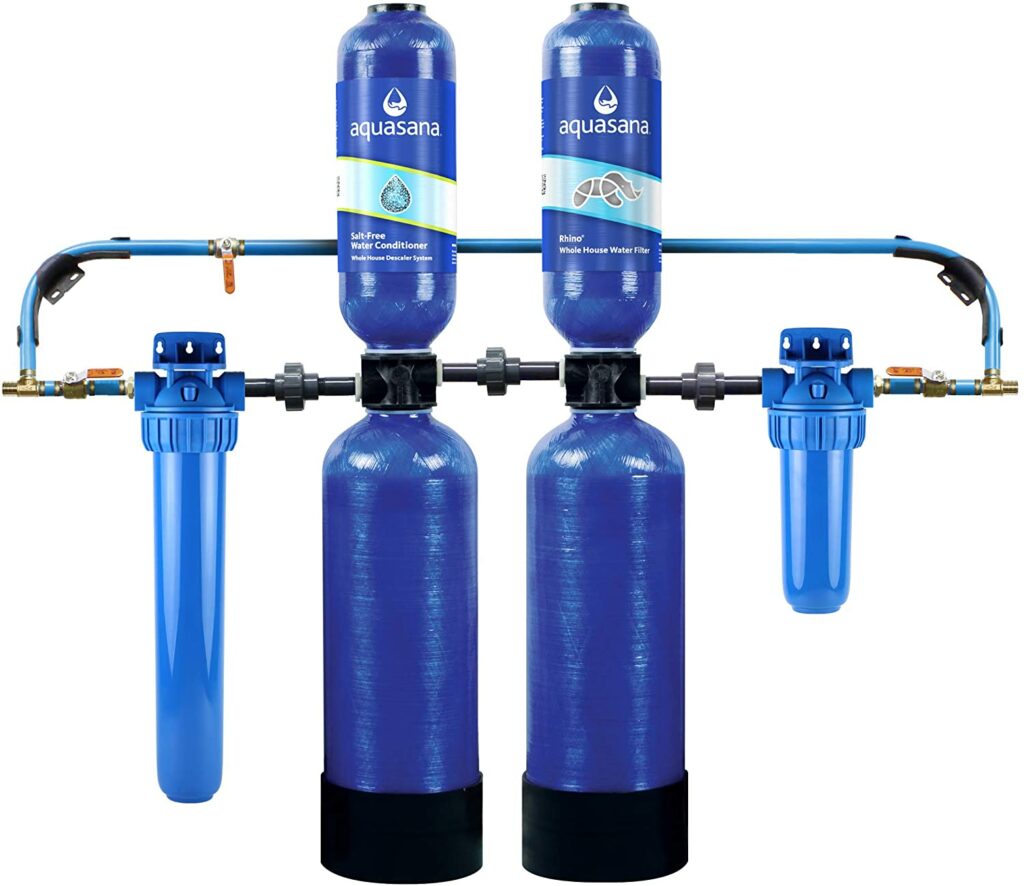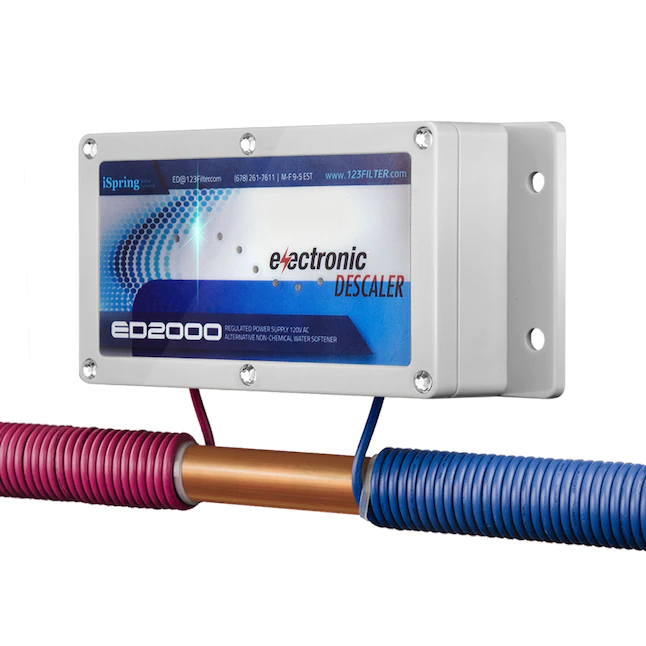When you notice white, cloudy stains (limescale) on the plastic surfaces in your home, there’s nothing to blame but hard water.
The presence of minerals like calcium and magnesium is what makes water hard. The molecules of these minerals have a tendency to cling together and adhere to surfaces. So, when the water withdraws, they lead to buildup in pipes and appliances and stains on kitchenware like plastic containers.
Don’t worry, though, as a bottle of white vinegar might be more than enough to take care of these stains, whether on a plastic surface or on your plastic containers.
In this article, we’re going to explain how to remove hard water stains from plastic surfaces and containers using white vinegar. Also, we’ll provide you with some permanent solutions that will take care of your hard water problems once and for all.
The Most Effective Tool to Remove Hard Water Stains from Plastic: White Vinegar

Minerals like calcium and magnesium are alkaline, and the best way to dislodge the buildup of their mineral molecules is to expose them to acidic liquids. Thanks to its acidic content, white vinegar happens to be the safest and most effective way to remove hard water stains from almost everything, including plastics.
Other cleaning agents like bleach can also be effective for this particular purpose. Still, we don’t recommend it since exposure to bleach in direct ways can be toxic because of its chemical ingredients.
So, let’s see how to apply white vinegar to clean plastic surfaces and containers.
How to Remove Hard Water Stains From Plastic Surfaces With White Vinegar
There are a few items and tools you need to have on hand before you start to treating plastic surfaces with white vinegar:
- White vinegar
- Water
- Sponge or cleaning cloth
- Empty spray bottle
- Soft brush
Once you have all that on hand, you can start:
- Wet a sponge or cleaning cloth and wipe off the dust or debris from the surface you want to clean
- Make a white vinegar solution with water. For every cup of vinegar, put a cup of water into the mixture. In other words, the mixture should have a 1:1 ratio of white vinegar and water.
- Put the mixture into a spray bottle
- Spray the mixture directly onto the stains
- Let the mixture remain on the stains for about 15 minutes so that the acidic content of the white vinegar and the alkaline content of the minerals can chemically react
- Scrub the stains meticulously with a soft brush
- Rinse with soft or boiled water
- If the stains are stubborn, repeat the process. For better results, you can wait for more than 15 minutes (maybe even overnight).
How to Remove Hard Water Stains from Plastic Containers With White Vinegar
You can follow the steps above to remove hard water stains from plastic containers, but containers have lots of vertical surfaces. When you spray the white vinegar mixture onto those vertical surfaces, it’ll just flow down, so it won’t be as effective as it is on horizontal surfaces.
So, these are the steps you should follow to effectively remove hard water stains from plastic containers:
- Fill a large pot with a 1:1 mixture of white vinegar and water
- Drop the stained plastic containers in this solution, making sure that all parts of the containers are submerged completely
- Wait for 15 to 20 minutes, so the solution can react with the mineral buildup
- Gently scrub the stains with a sponge or soft brush
- Rinse
- If the stains are stubborn, repeat the process. This time, let the containers soak even longer (overnight, if you can).
How to Protect Plastic Objects from Hard Water Stains
Let’s say you successfully cleaned all the hard water stains off all plastic objects in your household. Then what? In a couple of weeks, these stains will return unless you implement a solution that neutralizes the effects of hard water permanently.
Fortunately, various water treatment brands offer ample options for those who want to permanently take care of hard water. They come in the form of three different types of water treatment systems:
- Traditional, salt-based water-softening systems
- Salt-free water conditioning devices
- Electromagnetic water descalers
Now, let’s explain how these systems work with our favorite products in each category.
Salt-Based Water Softeners

Installing a good salt-based water softener, like the SpringWell SS1, which is our favorite product in its category, will help you a great deal in your struggle against hard water stains, including those on plastic objects and surfaces.
These systems might be expensive, as they cost about $1,500, and take too much space, as they feature two tanks (one for resin and another for brine). However, when compared to saltless and electromagnetic alternatives, they’re still the best solution for hard water.
Unsurprisingly, their efficiency is why salt-based water softening systems are almost synonymous with the term ‘water softener’ in the water treatment niche.
So, how does a salt-based system work?
- You install it at the main incoming pipe to your household
- The water enters the resin tank of the system, traveling through the resin
- This resin has a negative charge, which attracts and traps the positively charged molecules. As hard water minerals like calcium and magnesium are positively charged molecules, these minerals are not able to leave the resin.
- The negative charge of the resin is maintained by sodium or potassium molecules. Hence, the operation of salt-based water-softening devices is also known as ion exchange
- To flush the mineral buildup from the resin and recharge it with new sodium and potassium molecules, a sodium or potassium solution prepared in the brine tanks of these devices travel the system every once in a while (mostly once every two weeks). This process is known as the regeneration cycle, and it requires that there’s a certain level of water-softener salt always present inside the brine tank.
- For the regeneration cycle to take place effectively and for the whole system to continue operating efficiently, you need to renew the salt inside the brine tank
That said, these devices are already the most expensive solution to hard water issues, and the fact that you need to add new salt to them on a constant basis makes them even costlier long term. Additionally, you need to regularly clean and maintain both tanks of these devices, which means that they’re not low maintenance at all.
Still, they’re the most effective solution for preventing hard water stains.
Salt-Free Water Conditioners

When it comes to the reduction of limescale formation caused by hard water, salt-free water conditioners might seem a bit underwhelming with their 90% reduction rate, considering the traditional devices we mentioned above have a 99% reduction rate. However, this rate is still enough to deal with hard water stains on plastic – especially if you have a decent saltless system, like the Aquasana Salt-Free Water Conditioner.
Saltless units have a lower reduction rate because they don’t actually remove mineral molecules as salt systems do, and that’s why they’re labeled as ‘water conditioners.’ Rather, they feature a template that neutralizes the mineral molecules:
- Similar to salt-based systems, salt-free units are installed on the main incoming pipe
- They come with a tank
- As the water passes through this tank, the template within the system crystallizes the surfaces of the mineral molecules. This process is referred to as template-assisted crystallization (TAC).
- When crystallized, the mineral molecules can no longer stick together, cling to surfaces, build up in pipes, and adhere to plastics in the form of white and cloudy stains
Despite entertaining a lower scale reduction rate, saltless systems have some advantages over conventional, salt-based water softening units:
- Since only one tank is capable of handling this operation, salt-free conditioners occupy less space
- A decent system costs no more than $1,000, so they’re more affordable
- They don’t require you to put salt into the system, so they require less long-term expenditure
- They need no maintenance whatsoever unless something happens to the tank
All those advantages make salt-free systems present a worthy alternative to salt-based devices.
Electromagnetic Water Descalers

The efficiency of magnetic descalers has been up for debate in the water treatment niche and scientific circles for a while now, but research suggests that they’re able to reduce scale up to 50%. So, as long as your water supply is moderately hard, a trusted water-descaling unit, like the Yarna Capacitive Descaler, is capable of protecting your plastic objects from hard water stains.
As is the case with saltless systems, the reason why descalers have a lower reduction rate is that they don’t remove minerals. Instead, they aim to break down the bonds between mineral molecules through electric impulses:
- You mount the power source of your descaler on or near the main incoming water pipe of your household and plug it in
- You wrap its coil carefully around the pipe
- When you turn the device on, the power source creates an electromagnetic field.
- The impulses produced by this field travel through the coil, extending the field to the pipe.
- When the water passes through this field, the mineral molecules inside it break down
- Thus, they no longer have the chemical structure that makes them adhere to surfaces and cause buildup and stains
Of course, this operation is not as straightforward as the operation of saltless conditioners and salt-based softeners, as there’s no direct intervention to the contents of your water. Moreover, manufacturers like Yarna warn their customers that these devices might take two to three months to adjust their electric field to the hardness of your water supply.
That being said, they’re superior to more traditional alternatives when it comes to:
- Affordability: Electromagnetic water descalers cost between $200 to $400
- Space: These are very small devices that feature no tank
- Flow rate: Since water doesn’t take a detour in a tank, they don’t affect your flow rate
- No maintenance: Once installed and plugged in, they need no further maintenance
While all these are great features, their humble scale reduction rate (50%) makes them unsuitable for use in areas with particularly hard water.
Conclusion
Hard water can leave stains on whatever surface it touches, including plastic, because of its high mineral content.
To deal with these stains, you can engage in robust cleaning sessions that require lots of vinegar, but this doesn’t guarantee that the hard water stains won’t return.
To permanently remove hard water, you need to install a water-softening unit. Depending on your area’s water hardness and budget, you can install a traditional water softener, salt-free water conditioner, or electromagnetic water descaler and start enjoying stain-free appliances.